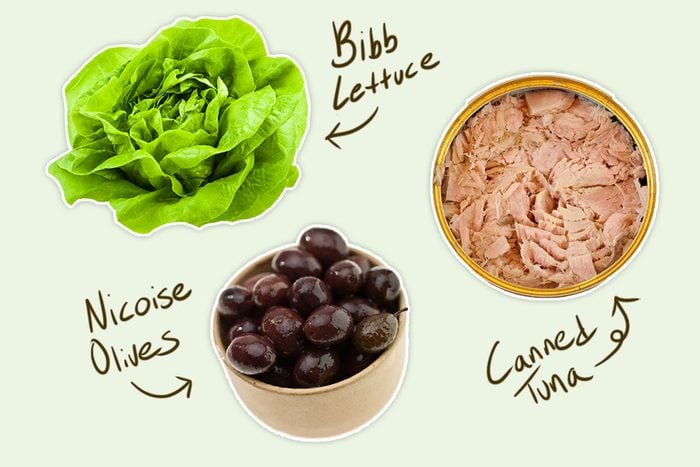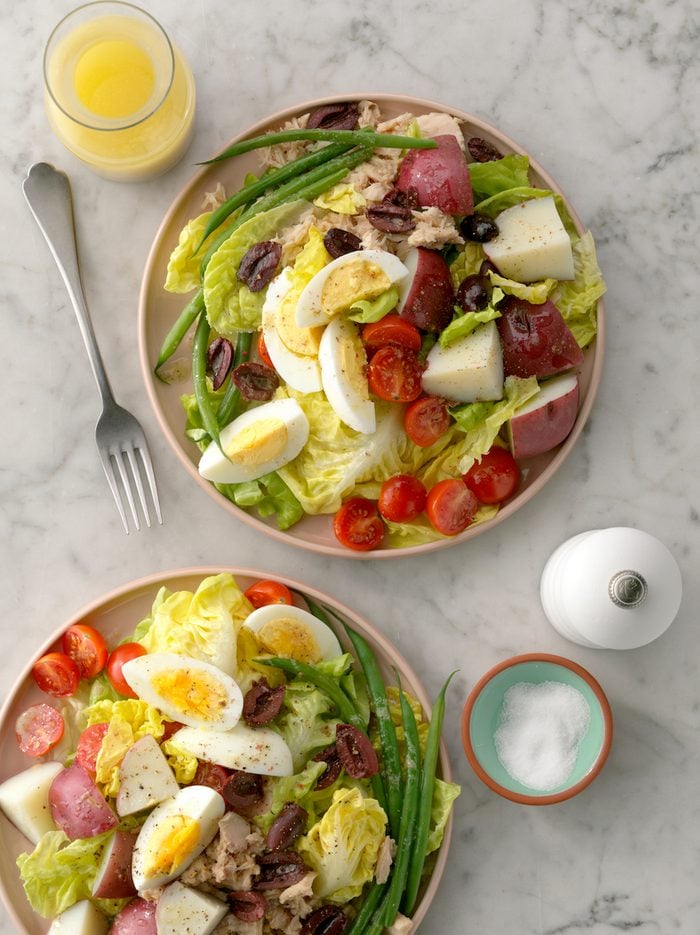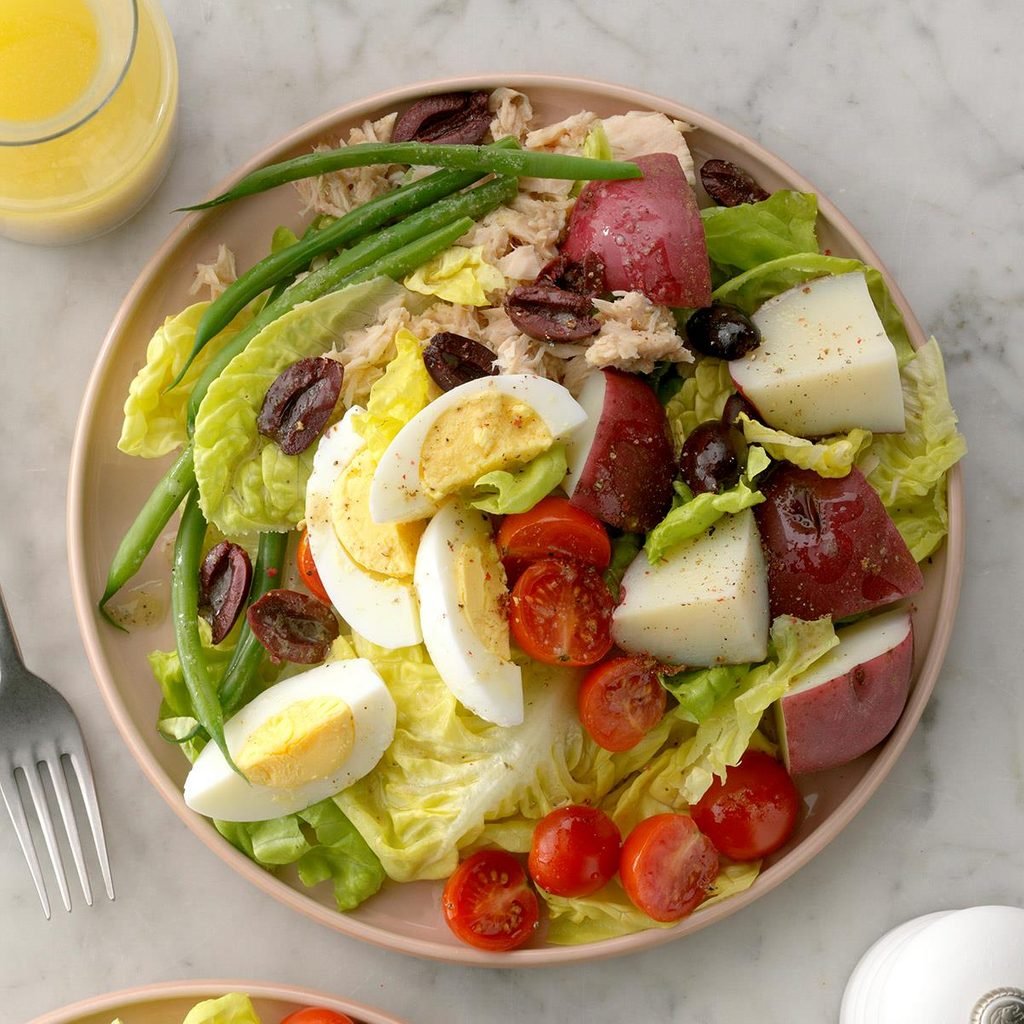There’s nothing quite as refreshing as a bed of crisp lettuce topped with the season’s best produce and dressed in a tangy vinaigrette The classic Nicoise salad hits all those notes: crisp green beans, soft potatoes, salty olives, juicy tomatoes, rich hard-boiled eggs and savory tuna. It somehow works as a light lunch or a filling dinner, all without changing the ingredients.
This French salad might seem like it’s fussy or requires adherence to strict rules, but we’ve found it’s strikingly easy to make. With a little prep work, this salad comes together in a matter of minutes. It’s also the perfect opportunity to use up leftovers from the fridge and produce that’s starting to wilt.
Let’s take a look at how to make a classic (and a not-so-classic) Nicoise salad.
What is a Nicoise salad?
Nicoise salad (pronounced nee-SWAZ) is a refreshing, colorful salad that comes from Nice, France. The salad was designed to celebrate the fresh produce available at the markets. It’s known as a composed salad. Ingredients are assembled on top of the lettuce instead of being tossed together with a dressing.
Today, most Nicoise salads contain green beans, hard-boiled eggs, olives, tomatoes and tuna, although many variations exist. Some people say it shouldn’t be made with lettuce—the toppings should be served on a bed of sliced tomatoes—while others say potatoes aren’t appropriate because the salad should contain raw vegetables only. However you choose to prepare it, Nicoise salad is all about celebrating fresh ingredients, so we recommend buying the highest-quality ingredients you can.
Key Ingredients for Nicoise Salad

- Bibb lettuce: This type of head lettuce has buttery-soft leaves that make a tender base. Boston or butter lettuce would work, too.
- Fresh veggies: Look to seasonal vegetables from the farmers market or fresh produce at the grocery store. Skip canned or frozen goods, if possible. They won’t have the crisp crunch you’re looking for in a fresh salad.
- Canned tuna: When shopping for tuna, choose water-packed tuna if you want to avoid extra fat and calories. Otherwise, oil-packed tuna is a great option for extra flavor. There’s no one best type of tuna—albacore, yellowfin or skipjack (also called light tuna)—but we like supporting pole-and-line caught or troll-caught brands. This method of fishing reduces bycatch and has the lowest impact on our ocean ecosystem.
- Nicoise olives: Traditional in this salad, Nicoise olives are small, brine-cured olives produced in the French Riviera. They vary in color from deep olive to tan, and they have a mild but savory flavor. If you can’t find them, feel free to substitute Greek or kalamata olives.
Directions
Step 1: Make the dressing
Combine the white wine vinegar, Dijon mustard, onion powder, salt and pepper in a small bowl. Add the olive oil in a slow, steady stream, whisking as you go. Set the dressing aside on the counter if you’re making the salad within the next hour or so. Otherwise, store the dressing in the refrigerator and let it come to room temperature before using.
Editor’s Tip: Homemade salad dressings are good for up to two weeks in the fridge, so feel free to make it in advance. The oil and vinegar will separate, so re-whisk the mixture or give it a firm shake to reincorporate the ingredients.
Step 2: Cook the veggies
The easiest way to cook the vegetables for this dish is on the stovetop. For the potatoes, place the whole red potatoes in a small saucepan and cover them with cold water. Bring the water to a boil. Then, reduce the heat to a simmer and cover the pot. Cook until the potatoes are tender, about 15 to 20 minutes. Drain and discard the cooking water and let the potatoes cool before cutting them into quarters.
For the green beans, blanching is best. Bring a small saucepan of salted water to a boil. When the water is boiling, add the green beans and cook for about 3 minutes, until they’re tender-crisp. Remove the beans to a bowl of ice water to cool them down.
Editor’s Tip: This part can be done in advance to make prep easier! Store the cooked potatoes and green beans in the refrigerator for up to two days before assembling the salad.
Step 3: Assemble the salad
With all the components prepared, this step is easy. Divide the lettuce between two salad bowls. Top each plate with half of the potatoes, beans, tomatoes, olives, hard-boiled eggs and tuna. Drizzle the salads with dressing and serve any extra dressing on the side.

Nicoise Salad Tips
What toppings can you add to a Nicoise salad?
While certain toppings are traditional, we like to think of the Nicoise salad as a blank canvas. Start by using the classic components as a base. Then, feel free to think outside the box and swap out a few ingredients.
- Instead of canned tuna, try using seared, oil-poached or grilled tuna instead. You can absolutely use another type of fish, too. We love salmon Nicoise almost as much as the original!
- If you want to really switch things up, swap-in grilled chicken breasts or steak, or make it vegetarian by using beans or tofu as a plant-based protein.
- Leftover roasted vegetables like beets, sweet potatoes or carrots work well, or you could toss market-fresh vegetables on the grill, like asparagus, sweet corn or zucchini.
- Don’t be afraid to add raw vegetables, either, like cucumbers or thinly sliced radishes for extra crunch.
- If you don’t have Bibb lettuce on hand, don’t worry! You can use any variety of lettuce, or you can make Nicoise salad with sliced tomatoes or asparagus as the base instead.
- If you like briny, pickled flavors, add capers, marinated artichoke hearts, different types of olives, pepperoncini, chopped pickles or anchovy filets.
How long will Nicoise salad last?
If you have leftover dressed salad, we’re sorry to tell you that you’re out of luck. The acid in the salad dressing wilts the tender lettuce, making it an unappetizing, soggy mess. To avoid waste, only dress however much salad you plan to eat in one sitting.
As for the salad components, you can totally prep this salad in advance and dress it when you’re ready to eat. It’s best to dry the lettuce so it doesn’t get soggy. You can meal prep by topping the lettuce with the remaining ingredients. Store the undressed salads in an airtight container for up to five days in the refrigerator.





















